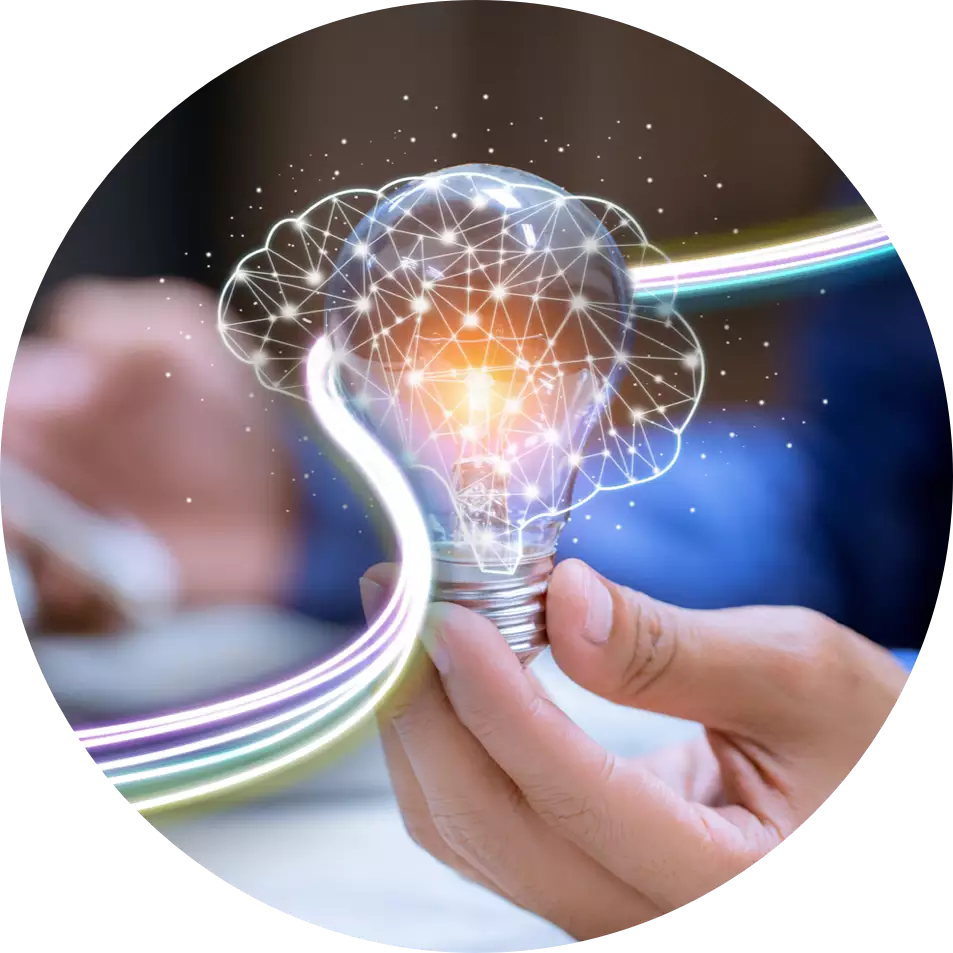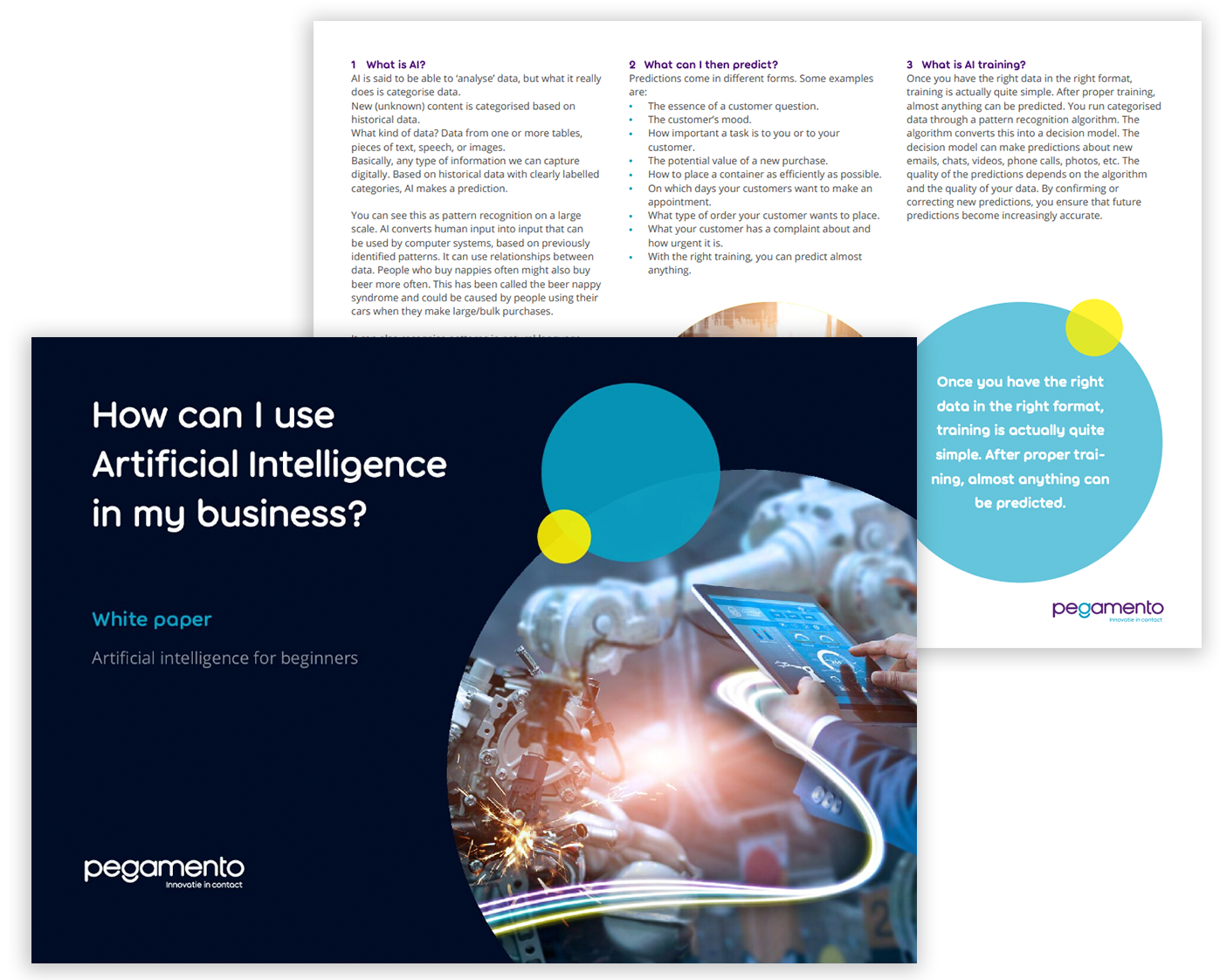What can I do with artificial intelligence within my organisation?
For over two years now, Pegamento has been implementing AI in various ways and in various orders of magnitude at companies in all kinds of sectors.
It is said that artificial intelligence can 'analyse' data, but in reality, what it is doing is categorising. New (unknown) content is categorised on the basis of data. What kind of data? Data from one or more tables, snippets of text, speech, or images. AI can read and use many different types of data in processes. Examples include pictures, emails, voice messages, and other digital content.
In fact, AI can use all forms of information that we can capture digitally. On the basis of data that contains clearly marked categories, AI makes a prediction.
Now that you know what artificial intelligence does, we will go further into what exactly artificial intelligence is and how it can be implemented. We will also share some case studies.
Here is a quick reading guide:

What is artificial intelligence?
Artificial Intelligence, or AI, is the ability of a system to correctly interpret external data, learn from this data, and use these lessons to achieve specific goals and tasks through flexible adaptation. You can think of this as pattern recognition on a large scale. AI converts human input into input that can be used by computer systems, based on previously detected patterns and a created neural network. It can use relationships between data, and it can also detect patterns in natural language. Interactions with lots of negative words, for example, might be more likely to be a complaint. Interactions with an appointment or reservation are more likely to contain a date. Google Home, Google Assistant, and Siri use speech-to-text conversion to guess what you are trying to say. These applications also work on the basis of previously categorised bits of speech. The prediction indicates to which category a new piece of content should be assigned. For example, that it is a complaint, or an order. It can also identify that you said the word 'Spotify' or the name of your favourite band. You can read more about AI/Machine learning/neural network and RPA here.
What can be predicted?
Predictions come in different forms. Some examples are: the essence of a customer demand, the customer's emotional mood, how important a task is to you or to your customer, the potential value of a new purchase, or how a container can be placed in the most efficient way. These are examples of the types of predictions an AI system can make. The system learns how to make these predictions through training.
Training the AI model
How does the process of training an AI system work? We explain this using an AI mail system as an example. In a workshop with users, we determine which email flows, such as changing address details, placing an order, and swapping a work day, are eligible for being handled by AI Mail Automation and which responses should accompany them. We define categories, such as invoice queries, lost customer cards, or returns, and establish where to find sample messages. Using a link to the email server, we import around 100 sample emails per stream. The AI model analyses the sample emails and trains itself on recognising the categories and recognising entities, such as a phone number or bank account number. We then use test messages to validate and further refine the model.
Mail Assistant, an example of artificial intelligence
What is Mail Assistant?
Mail Assistant is exactly what it says: automation of mail traffic using artificial intelligence (AI). By deploying artificial intelligence, the intent of emails is discovered in a learning process. Once the AI software knows what the emails are about, we deploy smart templates that can handle emails fully automatically. And in instances where this is not possible? The software then recognises this and immediately transfers the email to the right employee - either within the organisation or at an external location.
The advantages and disadvantages of artificial intelligence

Want to read further?

Pegamento implements AI in different ways and in various orders of magnitude at companies in all types of industries. In this white paper, we discuss our findings, recommendations, and implementation strategies

Some client cases in the field of Artificial Intelligence

Artificial Intelligence within your organisation?
Artificial intelligence can be applied in a wide range of production processes. Wherever patterns can be found, such as in customer intent, emails, or images, this technology can quickly add value! This technology is innovative, but it is also surprisingly affordable to deploy for process optimisation.
Could it be a solution for your business? What savings or quality improvements are possible in your processes?
Request an introductory meeting with one of our specialists to find out how Artificial Intelligence can be deployed within your organisation.

